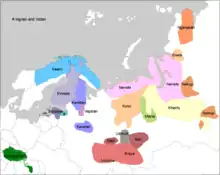
The Finno-Ugric peoples are a collection of ethnic groups who speak mostly Finno-Ugric languages and live in Northern Europe, some regions of the north of the European part of Russia, Volga region, Western Siberia, and Eastern and Central Europe.[1][2] Some Finno-Ugric peoples are very different culturally and anthropologically, live in different regions, but according to linguistic data[3] (partially confirmed by genetics and archeology) they descend from the ancient Proto-Finno-Ugric people. Linguistically, the closest peoples to the Finno-Ugric peoples are the peoples living in Siberia who speak Samoyedic languages; together they belong to the of the Uralic language family.
There are international congresses, conferences and other events that are held to study Finno-Ugric peoples: World Congress of Finno-Ugric Peoples,[4] International Congress for Finno-Ugric Studies,[5] International Finno-Ugric Students' Conference. At these forums the Finno-Ugric peoples are considered in the following aspects: linguistics, ethnography, archaeology, history, folkloristics, literature, mythology, sociology.[6][7]
List of peoples
Finno-Ugric archaeological cultures
Population genetics
Culture
Religion
References
- ↑ "The Finno-Ugric peoples". Encyclopædia Britannica.
- ↑ "The Finno-Ugric peoples". Estonian Non-Profit Organisation "Fenno-Ugria".
- ↑ Sámuel Gyarmathi (1983). Grammatical Proof of the Affinity of the Hungarian Language with Languages of Fennic Origin: (Gottingen Dieterich, 1799). John Benjamins Publishing. ISBN 978-90-272-0976-4.
- ↑ "World Congresses of Finno-Ugric Peoples from 1992 to 2021". Estonian Non-Profit Organisation "Fenno-Ugria".
- ↑ "13th International Congress for Finno-Ugric Studies". The Official website of University of Vienna.
- ↑ "Overview of programme with links to abstracts of 13th International Congress for Finno-Ugric Studies". The Official website of University of Vienna.
- ↑ "University of Tartu to Host Finno-Ugric Students Conference IFUSCO".